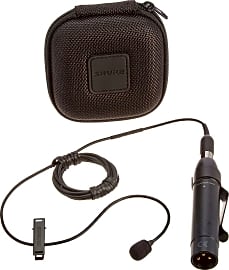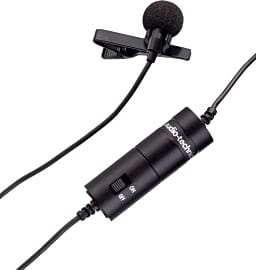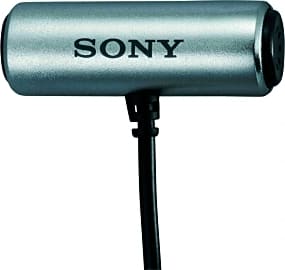The 10 Best Lavalier Microphones

This wiki has been updated 40 times since it was first published in December of 2016. Offering clip-on convenience, these lavalier microphones are designed to record or broadcast audio in a discreet manner, whether in live settings or on a narrative or documentary set. They are an ideal solution for tracking sound when the environment or filming angle isn't conducive to the use of a boom or a handheld mic. We've ranked them by sound quality, durability, and transmission range. When users buy our independently chosen editorial selections, we may earn commissions to help fund the Wiki.
Editor's Notes
December 08, 2020:
Two of the best options in this category have seen updates since our last visit to this ranking in the Rode Wireless Go White and the Sony Wireless UWP-D. Sony has taken their previously used LCD screen and swapped it out for a negative OLED display, which makes the details it shows much easier to read at a glance. Those screens are a bit smaller than their predecessors, however, so it didn't earn the model any higher ranking on the lst.
Rode's Filmmaker series was replaced by the Go models, which have had microphones built into their transmitters' bodies, allowing broadcasters, interviewees, and influencers to simply clip it to whatever they're wearing and use it. It does also have a microphone input for compatible lavs, which makes its useful for applications where you'd want to hide the mic, as well.
An important question is whether you want a standalone microphone or a system. Standalone mics like the Sanken COS-11D often offer superior sound quality to thoses packaged in systems, but these almost always become more expensive than systems, as you purchase each piece one at a time. To be fair, systems with quality hardware aren't cheap, either, but they do provide you with everything you need all at once.
July 04, 2019:
In previous incarnations of this ranking, models like the Rode SmartLav+ were given higher regards than they are today. There was a time when the level of convenience offered by being able to plug a mic into your smartphone was astronomical, as the phones were slim and easy to hide, the mics themselves were usually of a pretty high quality, and the software was rather thorough. While none of that has changed, iPhone users will quickly note that these mics have become all but useless to them unless they're willing to buy and use a 3.5mm adapter, as Apple has done away with the headphone jack. Still, we have a handful of such mics on our current list as they're still useful with other phones, and if you really wanted to you could theoretically buy up some old iPhones (generation 6s and older) and likely save money compared to some of the other transmitter/receiver models like the ones toward the top of our list.
Among those finer models in our higher positions, most are built with film production in mind, so their transmitters are usually as small as they can be. Sennheiser is undoubtedly the top dog in this department, even if Sony's rather capable system gave them a run for their money on our old list. For sound mixers, the low profile of the receiving unit is actually center stage with the AVX digital in our number one slot, as it will allow them to keep their packs smaller and more mobile. We've added a mic by Sanken to the list, as well, which is an industry standard in Hollywood for many filmmakers.
Above the likes of Sennheiser, Sony, and Sanken, there are a few other popular brands in the film industry, but like top-tier camera equipment, nobody really owns these; rather, they're rented by production houses whenever it comes time to make a film, and returned once production closes. Unless you intend to open a rental house, we'd advise against that kind of purchase.
Special Honors
DPA 6060 Series Subminiature Ideal for use in film, the mics from this company can be configured to function in environments of different sound intensities, and can be customized for wiring, connector material, clip style, and more. You can also have them finished in white, black, beige, or brown, allowing them to blend in with a variety of clothes and skin tones. They are, however, particularly expensive. dpamicrophones.com
Why Use A Lavalier Microphone?
It only picks her voice up if she speaks directly into it, and she spends the scene swaying her head back and forth, creating an unlistenable rush of poorly delivered lines.
There’s a wonderfully funny scene in the classic film Singin’ in the Rain, that pokes fun at the early days of talkies — that is, movies with sound. In it, a film director tries desperately to get his actress to speak in the direction of an enormous microphone that’s hidden away in a bush on set. It only picks her voice up if she speaks directly into it, and she spends the scene swaying her head back and forth, creating an unlistenable rush of poorly delivered lines.
It’s a funny scene, to be sure, but it also highlights a significant problem in film production that the advent of talkies initiated back in 1927. Simply put: bad sound is unforgivable. A wealth of picture issues, on the other hand (including lackluster special effects), often fail to register as significant faults with viewers. This most likely has to do with our willing suspension of disbelief. For some reason, though, we don’t extend filmmakers and documentarians the same length of rope when it comes to sound.
Bad sound in a beautifully shot film will pull you out of the experience. Think about those cheap overdub jobs that production houses in the 1970s applied to so many martial arts films. The image of those human mouths moving completely out of sync with the words on the soundtrack is so ubiquitous in the genre that it has since become an indelible comedy touchstone.
Most productions rely heavily on boom microphones to capture their audio. A shotgun microphone attached to the far end of a long boom pole allows sound mixers access to the spaces just outside of an image’s frame. From there, they can usually pick up enough high-quality audio to give the scene a professional sound level. The problem with these microphones is that they are susceptible to high winds, and they can pick up too much ambient noise if they’re positioned too far from a talking subject.
If that wind is too high, or if the framing of the shot necessitates that the boom operator bring his microphone too far from the actors to capture problem-free audio, the lavalier microphone will save the day. It can also be tremendously useful if you only have enough in your budget to work with a smaller crew, as a set of well-placed lavs may negate the need for a boom operator entirely, freeing your actors or interviewees to move about the space as they see fit.
Only The Sounds You Desire
Of course, with motion comes the one big drawback from lavalier microphones: clothing rustle. By necessity, these little mics have to be very sensitive. They’re designed to capture high-quality audio, often from beneath one of more layers of clothing. If your subject is relatively motionless, that audio should record very cleanly. Small amounts of motion, however, will often create audio tracks in which the sound of clothing rubbing against the microphone far outshines the dialogue you hope to capture. Even if the dialogue rises above the level of the rustle, the mere presence of the rustle will likely render your audio useless.
For starters, there are some products out there that are specifically designed for this purpose.
In documentary cases, the easiest solution is to mount the lav mic somewhere above the clothing, often clipped to a tie or the edge of a jacket. Documentary is unique in this case, as there’s little attempt on the part of a director to obscure the line between fact and fiction; the presence of a visible microphone may actually cause viewers to believe your story more deeply, even if you use other, more dramatized methods to put it all together.
A visible microphone won’t go over as well with film audiences who expect you to whisk them away to another place. Websites like IMDb and others often trade in “gotcha” moments where you can see evidence of a production, such as the visible microphone pack on Walter White’s back in the Breaking Bad pilot episode, or the hanging figure in the Wizard of Oz that may or may not be a munchkin suicide.
To save yourself a lot of such trouble, you’ll want to hide your actors’ mics somewhere on their bodies. This might create a lot of clothing noise, but there are a few tricks you can use to get around it. For starters, there are some products out there that are specifically designed for this purpose. The same companies that produce the microphones make many of them, and these will often provide you with the best fit. You may also want to look into some DIY methods, however, as these can mimic a lot of what the on-brand solutions do to cut down on rustle, but at a fraction of the cost.
Also, keeping these mics in place is vital to reducing unwanted noises, and you can’t simply clip them to clothing if you want them to remain hidden. Invest in a little medical tape — the kind you would use to secure gauze to skin — as this will hold your lavs in place against any bare flesh that might prove a convenient staging ground.
Which Lav Will You Love?
Your selection of a lavalier microphone system will hinge on your intended uses for the device. As evidenced above, necessities of size and placement will have a lot to do with your decision, and a documentarian will have different needs than a fiction filmmaker.
For fiction filmmakers, the ability to conceal whatever option you choose is paramount.
If you’re a documentarian, or you work in any other field where a visible microphone won’t detract from your production, you can afford to focus less on how small a given model is, or on how easy it otherwise may be to conceal, and more on its overall fidelity or wireless range.
For fiction filmmakers, the ability to conceal whatever option you choose is paramount. In addition to the mic itself, however, you also need to concern yourself with the transmitter pack that runs to a wireless receiver. If you can’t stand the idea of a pack showing up on a character that needs to move around a lot in a frame, take a good look at some of the smartphone-compatible models out there. These plug directly into any cell phone with a 3.5mm jack, and allow your actors to merely appear as though they have their phone in a pocket, providing a naturalistic solution to your audio problem.















